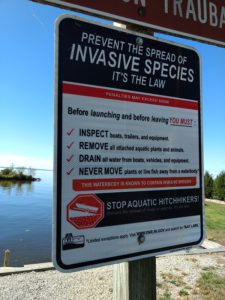Every month, we will put a spotlight on an aquatic invasive species (AIS) in a re-occurring monthly article. Check it out! Since it’s February and Valentine’s Day is right around the corner, we are highlight two similar invasive species that are like peas in a pod: Spiny and Fishhook waterfleas!
Spiny Waterflea and Fishhook Waterflea
Spiny waterflea (Bythotrephes longimanus) and fishhook waterflea (Cercopagis pengoi) are AIS that share similar life histories and cause similar impacts when they invade waterbodies. For these reasons, they are often discussed together.
Both spiny waterflea and fishhook waterflea are zooplankton that have long tail spines. Spiny waterfleas grow to be about 0.6 inches and have a tail spine that is twice as long as its body. The tail has one to three barbs on it. Spiny waterfleas can either reproduce sexually or clone themselves. If new individuals are clones,  they have a kink in their tail. If new individuals are created sexually, they do not have a kink in the tail.
they have a kink in their tail. If new individuals are created sexually, they do not have a kink in the tail.
Fishhook waterfleas grow to be anywhere from 0.2 – 0.5 inches and also have a tail spine that is 2x – 4x the size of the body. The fishhook waterflea has three pairs of barbs on the tail. The most distinguishable feature is the loop at the end of the tail that resembles a fishhook.
Spiny and fishhook waterfleas are native to Europe and Asia and were brought to the Great Lakes in ballast water from trans-Atlantic ships. However, due to the life history of the waterfleas, these species may have arrived to the Great Lakes as resting eggs (fertilized eggs that are shed in Autumn to “rest” in the lake bottom sediments and hatch the following Spring).
Spiny waterflea adults tend to be most abundant in late summer and early fall in the upper portions of invaded lakes (a.k.a. epilimnion). They can tolerate a wide range of environmental conditions but are most numerous when water temperatures are between  50°F-75.2°F. Spiny waterfleas can also tolerate salinity ranges between 0.04 – 8.0 ‰. However, it has been documented that spiny waterfleas are more numerous in systems with water temperatures closer to the lower end of their temperature tolerance.
50°F-75.2°F. Spiny waterfleas can also tolerate salinity ranges between 0.04 – 8.0 ‰. However, it has been documented that spiny waterfleas are more numerous in systems with water temperatures closer to the lower end of their temperature tolerance.
Fishhook waterfleas thrive in similar conditions. Both species reproduce asexually by creating clones during most of the summer but will switch to sexual reproduction to create resting eggs during Autumn or as environmental conditions become less than favorable (e.g., less food, colder water temperatures, etc.). Both of these waterflea species feed on other smaller zooplankton.
 Spiny and fishhook waterfleas cause similar impacts on invaded systems by changing the zooplankton community and interfering with recreational activities. Both spiny and fishhook waterfleas feed on the same zooplankton that larval fish depend on for food. It is also difficult for many larval fish to eat spiny and fishhook waterfleas due to the tail spines on the waterfleas. Interestingly, these waterfleas have been documented to have been a factor in the decline of the invasive alewife in the Great Lakes as alewives also have difficulties eating these waterfleas.
Spiny and fishhook waterfleas cause similar impacts on invaded systems by changing the zooplankton community and interfering with recreational activities. Both spiny and fishhook waterfleas feed on the same zooplankton that larval fish depend on for food. It is also difficult for many larval fish to eat spiny and fishhook waterfleas due to the tail spines on the waterfleas. Interestingly, these waterfleas have been documented to have been a factor in the decline of the invasive alewife in the Great Lakes as alewives also have difficulties eating these waterfleas.
Both fishhook and spiny waterfleas are commonly first found in newly invaded waterbodies by anglers. Due to the long tail spines, spiny and fishhook waterfleas get tangled on fishing line and foul the fishing gear. There has been some research that suggests spiny waterfleas may control the abundance of fishhook waterfleas due to competition for food and predation when both species have invaded the same waterbody but more research is needed.
Both spiny and fishhook waterfleas are Prohibited in all counties in Wisconsin.
Want to help? HELP PREVENT THE SPREAD!
Every time you come off the water, make sure to follow these steps to stop the spread of faucet snails and other aquatic invasive species:
* Inspect boats, trailers, push poles, anchors, and other equipment for attached aquatic plants or animals.
* Remove all attached plants or animals
* Drain all water from boats, motors, livewells and other equipment
* Never move live fish away from a waterbody
* Never release aquarium plants or animals into your local waterways
Follow the Fox Wolf Watershed Alliance’s Winnebago Waterways Program on our Winnebago Waterways Facebook page or @WinnWaterways on Twitter! You can also sign-up for email updates at WinnebagoWaterways.org.
Questions? Comments? Contact Chris Acy, the AIS Coordinator for the Winnebago Waterways Program covering Fond du Lac, Calumet, and Winnebago Counties at (920) 460-3674 or chris@fwwa.org!
Winnebago Waterways is a Fox-Wolf Watershed Alliance program. The Fox-Wolf Watershed Alliance is an independent nonprofit organization that identifies and advocates effective policies and actions that protect, restore, and sustain water resources in the Fox-Wolf River Basin.
All text from this article is from the Winnebago Waterways AIS Strategic Plan. Sources can be found in the AIS Strategic Plan document.
Photo Credit: Minnesota Sea Grant, modified image
